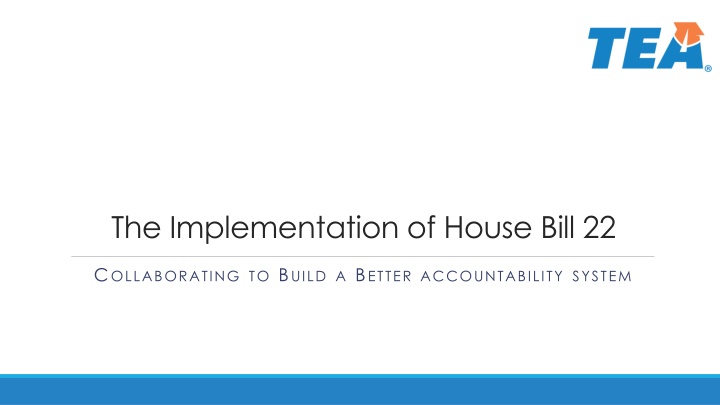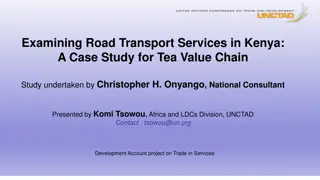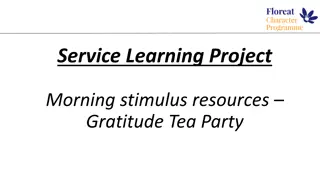
Collaborating for Accountability: House Bill 22 Implementation Update
Explore the implementation of House Bill 22 focusing on accountability in the Texas education system. Learn about the legislative context, stakeholder input, scoring methodology, philosophical commitments, new grading system, and student achievement criteria.
Uploaded on | 1 Views
Download Presentation

Please find below an Image/Link to download the presentation.
The content on the website is provided AS IS for your information and personal use only. It may not be sold, licensed, or shared on other websites without obtaining consent from the author. If you encounter any issues during the download, it is possible that the publisher has removed the file from their server.
You are allowed to download the files provided on this website for personal or commercial use, subject to the condition that they are used lawfully. All files are the property of their respective owners.
The content on the website is provided AS IS for your information and personal use only. It may not be sold, licensed, or shared on other websites without obtaining consent from the author.
E N D
Presentation Transcript
The Implementation of House Bill 22 COLLABORATING TO BUILD A BETTER ACCOUNTABILITY SYSTEM
AF Accountability: Legislative Context HB 22 HB 2804 House Bill 22, 85th Texas Legislature The commissioner shall evaluate school district and campus performance and assign each district and campus an overall performance rating of A B C D or F 2
AF Accountability: Gathering Stakeholder Input House Bill 22, 85th Texas Legislature Feedback Opportunities Solicit input on the aspects over which commissioner has authority. . . . the commissioner shall solicit input statewide from persons . . ., including school district boards of trustees, administrators and teachers employed by school districts, parents of students enrolled in school districts, and other interested stakeholders. Not solicit input on aspects that are required by statute 3
Three Domains: Combining to Calculate Overall Score Best of Achievement or Progress Minimum 30% Feedback Opportunities Certain methodology decisions in each domain Student Achievement School Progress Closing The Gaps Cut points for each grade in each domain Weight (30% or more) to Closing the Gaps Domain 4 4
Design Approach: Philosophical Commitments The commissioner shall ensure that the method used to evaluate performance is implemented in a manner that provides the mathematical possibility that all districts and campuses receive an A rating. No Forced Distribution 1 Law switched from annually to periodically We WANT stability in the model, we do not want the bar to keep changing. We want to commit to something where the bar will remain static for 5 years, where the rules don t change. 2 5
AF Accountability: New Labels/Grades A = Exemplary Performance B = Recognized Performance C = Acceptable Performance D= In Need of Improvement F = Unacceptable Performance 6
Student Achievement: Performance School Progress Closing The Gaps Student Achievement Approaches or Above Meets or Above Masters 7 7
Student Achievement: Calculating Score Texas Higher Education Coordinating Board By 2030, at least 60 percent of Texans ages 25 34 will have a certificate or degree. Student Achievement Score A All Students 3,212 Total Tests # Approaches or Above 2,977 Average of 3 # Meets or Above 1,945 =60.2 / 3 92.7 + 60.6 + 27.3 # Masters 878 % Approaches Grade Level or Above 92.7% 60.6% % Meets Grade Level or Above % Masters Grade Level 27.3% 8 8
Student Achievement: Calculating Score Elementary School Middle School Feedback Opportunity Weighting of Three High-School Components College, Career, Military Ready (CCM-R) Graduation Rates High School 9
Student Achievement: CCM-R Indicators for HS College Ready Career Ready Meet criteria on AP/IB exams Meet TSI criteria (SAT/ACT/TSIA) in Reading and Mathematics Complete college prep course offered by a partnership between a district and higher education institution Complete dual credit Complete OnRamps courses Earn an associate s degree Meet standards on composite of indicators indicating college readiness Earn industry certification Be admitted to post-secondary industry certification program Military Ready Enlist in the Armed Forces 10
School Progress: Growth Student Achievement Closing The Gaps School Progress 11
School Progress: Two Aspects to Progress Student Growth Relative Performance Feedback Opportunities Better of the Two Average of the Two Greater Weight for One of Them 12
Student Growth: Measuring Advancement Masters Exceeds + 1 Point Awarded For meeting or exceeding expected growth Masters STAAR Performance Level Meets Expected Meets + .5 Points Awarded For maintaining proficiency but failing to meet expected growth Maintains Approaches Approaches + 0 Points Awarded For falling to a lower level Does Not Meet Limited Does Not Meet 4th Grade Example 3rd Grade Example Feedback Opportunity What percent of students should meet growth target or each grade A F? 1 313
Student Growth: Percent of Students Gaining Current Year Does Not Approach Grade Level Approaches Grade Level Meets Grade Level Masters Grade Level Does Not Approach Grade Level Met/Exceeded Met/Exceeded 1 pt 1 pt Growth Measure = 1 pt Growth Measure = 1 pt Did not meet = 0 pts Did not meet = .5 pts Met/Exceeded Met/Exceeded Previous Year Approaches Grade Level 1 pt 1 pt Growth Measure = 1 pt Growth Measure = 1 pt Did not meet = 0 pts Did not meet = .5 pts Meets Grade Level 0 pts 0 pts 1 pt 1 pt Masters Grade Level 0 pts 0 pts 0 pts 1 pt 14
Student Growth: Percent of Students Gaining Current Year Does Not Approach Grade Level Approaches Grade Level Meets Grade Level Masters Grade Level Does Not Approach Grade Level Met/Exceeded Met/Exceeded 1 pt 1 pt Growth Measure = 1 pt Growth Measure = 1 pt Did not meet = 0 pts Did not meet = .5 pts Met/Exceeded Met/Exceeded Previous Year Approaches Grade Level 1 pt 1 pt Growth Measure = 1 pt Growth Measure = 1 pt Did not meet = 0 pts Did not meet = .5 pts Meets Grade Level 0 pts 0 pts 1 pt 1 pt Masters Grade Level 0 pts 0 pts 0 pts 1 pt 1 515
Student Growth: Percent of Students Gaining Current Year Does Not Approach Grade Level Approaches Grade Level Meets Grade Level Masters Grade Level Does Not Approach Grade Level Met/Exceeded Met/Exceeded Growth Measure = 1 pt Growth Measure = 1 pt 1 pt 1 pt Did not meet = 0 pts Did not meet = .5 pts Met/Exceeded Met/Exceeded Previous Year Approaches Grade Level Growth Measure = 1 pt Growth Measure = 1 pt 1 pt 1 pt Did not meet = 0 pts Did not meet = .5 pts Meets Grade Level 0 pts 0 pts 1 pt 1 pt Masters Grade Level 0 pts 0 pts 0 pts 1 pt 1 616
Student Growth: Percent of Students Gaining Current Year Does Not Approach Grade Level Approaches Grade Level Meets Grade Level Masters Grade Level Does Not Approach Grade Level Met/Exceeded Met/Exceeded Growth Measure = 1 pt Growth Measure = 1 pt 1 pt 1 pt Did not meet = 0 pts Did not meet = .5 pts Met/Exceeded Met/Exceeded Previous Year Approaches Grade Level Growth Measure = 1 pt Growth Measure = 1 pt 1 pt 1 pt Did not meet = 0 pts Did not meet = .5 pts Meets Grade Level 0 pts 0 pts 1 pt 1 pt Masters Grade Level 0 pts 0 pts 0 pts 1 pt 1 717
Relative Performance: Measuring School Progress Higher Levels of Student Achievement A campus with fewer economically disadvantaged students on average has higher levels of student achievement Domain Score for All Students Student Achievement A campus with more economically disadvantaged students tends to have lower levels of student achievement Higher Rates of Economically Disadvantaged % Economically Disadvantaged Students 1 818
Relative Performance: Measuring School Progress Higher Levels of Student Achievement Domain Score for All Students A B C D F Student Achievement Higher Rates of Economically Disadvantaged % Economically Disadvantaged Students 1 919
Closing the Gaps: Ensuring Educational Equity Student Achievement School Progress Closing The Gaps 20
Closing the Gaps: Ensuring Educational Equity All Students Continuously Enrolled and Mobile Students Special Education English Learners Race/Ethnicity x 21
Closing the Gaps: Ensuring Educational Equity Subgroups Indicators All Students African American Hispanic White American Indian Asian Pacific Islander Two or More Races Economically Disadvantaged Current and Former Special Education Current and Monitored English Language Learners Continuously Enrolled/Non-Continuously Enrolled Academic Achievement in Reading, Mathematics, Writing, Science and Social Studies Growth in Reading and Mathematics (Elementary and Middle Schools) Graduation Rates English Learner Language Proficiency College, Career, and Military Readiness Performance At or Above Meets Grade Level Performance in Reading and Mathematics 22
Closing the Gaps: Ensuring Educational Equity Subgroup Achievement Target % of Subgroups that meet target Overall Grade 23
Local Accountability Plan: Local Accountability *Example *Example Sa Extra- Curricular Activities Local Student Achievement School Progress Closing The Gaps Assessments 24
Local Accountability Plan: Purpose and Requirements Purpose More Requirements for Districts To allow campuses to be rated using locally developed domains and accountability measures Calculations must be auditable Campus score card that may be displayed on TEA s website Publicly available explanation of the methodology used to assign ratings Plans submitted to TEA for approval Requirements for Districts Include the TEA-assigned three domain performance ratings (at least 50% of the overall rating). Locally developed domain and measures must provide for the assignment of A F grades, and be reliable and valid. Feedback Opportunity Volunteer to participate in the pilot program 25
Local Accountability Plan: Getting the Plan Approved Authority One Condition The commissioner has authority to develop the process to approve requests by school districts or open-enrollment charter schools to assign campus performance ratings. Locally developed accountability system only for campuses that were not assigned an overall rating of D or F by TEA. Requirements for Approval The agency determines whether the plan meets the minimum requirements An audit conducted by the agency verifies calculations included in the plan A review panel approves the plan Feedback Opportunity Volunteer to participate in the pilot program 26
New Indicator: Extracurriculuar/Cocurricular Feasibility Study Report Determine the feasibility of incorporating indicators that account for extracurricular and cocurricular student activity Commissioner may establish an advisory committee Report to the legislature on the feasibility of these indicators by December 1, 2022, Unless a similar indicator is adopted prior to December 1, 2022 Feedback Opportunities Suggestions for Extracurricular or Cocurricular Indicator Volunteer to Serve on a Committee 27
AF Timeline: Implementation of HB 22 Start of pilot group to design local accountability (Fall 2017) Campuses: A F labels take effect and local accountability system is incorporated (August 2019) Rules adopted for local accountability system and application window opens (Fall 2018) Rules finalized for three domain system (Spring 2018) HB 22 Passed by the 85th Texas Legislature (May 2017) Task Force launches on how to incorporate extracurricular activities (Winter 2017) Three domain system rates all campuses and districts. Takes effect as follows: Districts: A F Rating Labels Campuses: Improvement Required or Met Standard (August 2018) What If report on Campus performance, based on data used to assign 2018 ratings. (January 2019) 2 828
AF Timeline: Domain Development Expected Timeline Activity Stakeholder feedback ATAC and APAC monthly subcommittee meetings Training Sessions with ESC: HB 22 Overview and Student Achievement Domain Training Sessions with ESC: School Progress Domain Aug. December 2017 Training Sessions with ESC: Closing the Gaps Domain September 18 19, ATAC meeting October 11 12, APAC meeting November, ATAC meeting (final recommendations for 2018 A F) December, APAC meeting (final recommendations for 2018 A F) Continued stakeholder feedback January April 2018 Commissioner final 2018 A F decisions 2018 A F accountability manual creation May June 2018 Public comment on A F accountability manual 2018 A F Manual adoption 2 929
AF Timeline: Local Accountability Expected Timeline Activity Stakeholder feedback ATAC and APAC monthly subcommittee meetings September 18 19, ATAC meeting October 11 12, APAC meeting Aug. December 2017 Launch of Local Accountability System Pilot November, ATAC meeting (final recommendations for 2018 A F) December, APAC meeting (final recommendations for 2018 A F) Continued stakeholder feedback January April 2018 Commissioner final 2018 A F decisions Ongoing Local Accountability System Pilot 2018 A F manual creation Public comment on A F manual May June 2018 2018 A F manual adoption Ongoing Local Accountability System Pilot June 2018 April 2019 Ongoing Local Accountability System Pilot 3 030






















